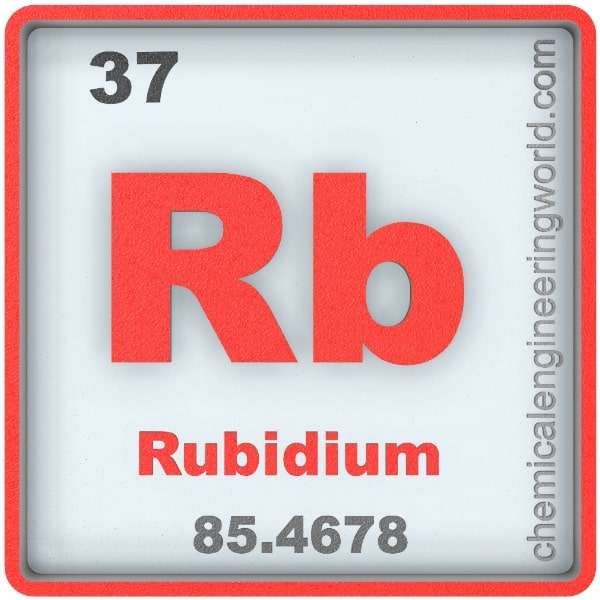Rubidium Element Properties and Information

Rubidium Element Properties and Information
Rubidium is thirty-seventh element on the periodic table. Elements are arranged in the periodic table on the basis of the atomic number. Atomic number is the number of protons in the nucleus of the atom. Rubidium has an atomic number of 37. It is located in the Group 1 and Period 5 of the periodic table of elements. It is denoted by Rb. The name is derived from the Latin ‘Rubidius’ meaning Deepest Red.
Robert Bunsen and Gustav Kirchhoff dissolved lepilodite ore in acid and they removed the precipitate and carefully using boiling water they removed even the lightest boiling potassium. They analysed and found that it contained a new element, the atomic spectrum showed ruby red line which was never seen before. The new element was named after this colour as rubidium.
Rubidium is twenty-third most abundant element in Earth’s crust. It occurs in the minerals pollucite, carnallite, leucite and lepidolite.
Physical Properties
- Rubidium is a soft, ductile, and silvery-white alkali metal.
- The atomic mass of rubidium is 85.4678.
- The melting point of rubidium is 39°C
- The boiling point of rubidium is 696°C
- The density of rubidium is 1530 in S.I. units at 20°C
- Rubidium is the second most electropositive among all alkali metals.
- Rubidium metal reacts violently with water.
- Rubidium has two stable isotopes; rubidium-85 and rubidium-87.
Chemical Properties
- Rubidium burns with a purple flame.
- Rubidium chloride is the most used rubidium compound among all of its compounds. It is used in living cells to take up DNA and also as a Bio marker.
- Rubidium forms salts with the halides.
Methods of Production
Fractional Crystallization: Rubidium-ceasium alum is fractionally crystallised such that in about 30 subsequent steps pure rubidium alum is obtained.
Relevance in Chemical and Related Industries
Working Fluid: Rubidium is used as a working fluid in vapour turbines as getter in vacuum tubes.
Relevance in Other Industries
- Fire Works: Rubidium compounds are sometimes used in fireworks to give them purple colour.
- Generator: Hot rubidium ions are used in thermoelectric generator.
- Laser-cooling: Rubidium-87 is one of the most commonly used atomic species for laser cooling and Bose-Einstien condensate.
- Atomic clocks: Atomic clocks utilize rubidium. It is useful for high precision timing.
Health Effects on Exposure
Burns: Rubidium is reactive with water. When it comes in contact with moisture in skin and eyes, it burns them.
Effects on Surroundings
- Plants: Plants absorb rubidium very quickly. This causes potassium deficiency in the long run.
Reference:
https://en.m.wikipedia.org/wiki/Rubidium
https://www.lenntech.com/periodic/elements/rb.htm
https://www.rsc.org/periodic-table/element/37/rubidium
































